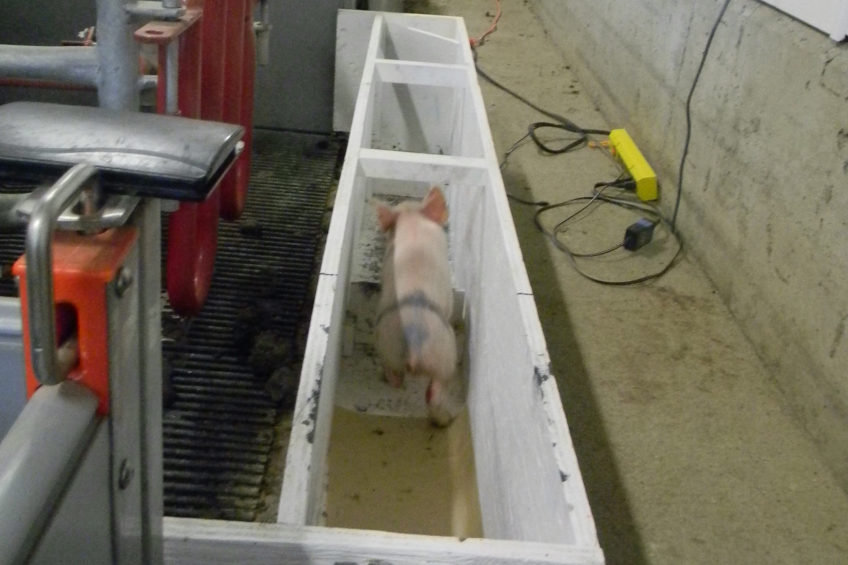Sugar: Solution for pain control in piglets?

A spoonful of sugar helps the medicine go down, but can it also help to treat pain during, say, castration or tail-docking? Research at Canada’s Prairie Swine Centre was done to evaluate the outcomes. The piglets’ behavioural responses look particularly hopeful.
Pain control is an important area for the global pork industry to address concerns over pig welfare and the ethics of performing painful husbandry procedures on piglets shortly after birth, such as castration or tail-docking. It is becoming less acceptable to allow routine management procedures that inflict pain on pigs to continue without alleviating the pain. This has led to legislative and code-of-practice changes around the world which require pain control for painful husbandry procedures or alternatives to procedures such as tail-docking and castration.
Recent research at the Prairie Swine Centre (PSC) explored whether sugar could play a useful role in controlling pain in piglets following castration. The choice was obvious: there is a long history of using sugar to alleviate pain in human infants during procedures such as neonatal heel prick, vaccination, blood sampling and circumcision. So why not try pigs?
Piglet procedures – castration, tail-docking, teeth clipping
The global swine industry routinely performs painful procedures on piglets after birth, such as castration, tail-docking, teeth-clipping and identification (ear notching, tagging or tattooing). Collectively, these procedures are referred to as piglet processing. Outside of the EU, pain control is generally not provided. The processing of piglets involves both immediate and longer-term pain, potentially lasting several days.

Krista Davis, BSc: “There is a long history of using sugar to alleviate pain in human infants.”
There is substantial evidence that castration is a particularly painful procedure. The scrotum and spermatic cords have a rich supply of nerves, and piglets show strong physiological and behavioural indications of pain during processing. Processed piglets vocalise more during the procedure than those that are only handled and tail-docked piglets grunt more after processing and have been observed jamming and wagging their tails more frequently.
Piglets castrated without pain control were also found to spend more time away from other piglets and the sow and to perform more pain-related behaviours, compared with piglets handled similarly but not castrated. Piglets castrated without pain control show a greater increase in the stress hormone, cortisol, following the procedure, indicating that castration without pain control causes greater stress.
Similarly, piglets that were tail-docked had a greater cortisol response than those that were handled but not docked. Taken together, these physiological and behavioural differences provide clear evidence that processing is painful.
Due to the pain experienced by piglets during processing, these husbandry procedures have been broadly criticised. In Canada, the newly revised Code of Practice for the Care and Handling of Pigs requires, as of 1 July 2016, that castration be performed with analgesics to control post-procedural pain. The European Union (EU) has proposed a voluntary ban on castration as of 2018 and currently requires that pain medication be used. In the USA, no pain mitigation is required and no analgesic drugs have been approved for the treatment of piglets. Realistically, some degree of piglet processing is likely to continue, e.g. tail-docking, for which there are currently few viable alternatives to reduce tail biting. So from an ethical standpoint, the swine industry needs to identify more effective pain control options to reduce pain.
Treatments mentioned in figure above:
1. Con: Castration control;
2. SugA: Sugar after castration;
3. SugB: Sugar before castration;
4. Sham: Piglets handled only and not castrated;
5. SugSham: Piglets handled only and given sugar.
Options for controlling pain during the castration procedure include general or local anaesthetics, such as lidocaine, an injectable numbing agent. Analgesic drugs are then used to control post-procedure pain. Meloxicam and ketoprofen are the most widely studied analgesics for controlling post-pro-cedural pain in the non-steroidal anti-inflammatory class of drugs (NSAIDs). One limitation of NSAIDs is that they take about 20 minutes after administration to take effect. So, if the goal is to control pain immediately after surgery, then the drugs need to be administered well before processing. Piglets would need to be handled twice, increasing labour requirements and imposing greater handling stress on the animals.
Recent studies have shown that the stress imposed on piglets is directly related to the handling time for procedures. Furthermore, the cost and labour of providing both analgesia and anaesthesia at processing are significant. When evaluating these procedures.
Sucrose: Reducing pain in piglets
Sucrose (sugar) has been shown to reduce pain in humans and rodents and may offer an economically viable and effective solution to help reduce processing pain in piglets. When fed an oral sugar solution before a painful procedure, rats displayed fewer pain behaviours and had reduced levels of corticosterone. Table sugar is inexpensive and can be easily prepared in a solution that is given orally at the time of processing.
Although its precise actions are unknown, sugar is believed to act immediately through taste receptors to activate the endog-enous opioid system. It could therefore hold potential for a low-cost method of pain control for producers – reducing pain immediately after surgery. If combined with an analgesic, it could provide some initial pain mediation while NSAIDs take effect and avoid the problem of handling piglets twice.
The Prairie Swine Centre (PSC) investigated the effectiveness of an oral sucrose solution at relieving pain in piglets following castration. Five treatments were tested:
1. Control group: piglets castrated without pain control;
2. Sugar given before castration;
3. Sugar given after castration;
4. Sham castration with sugar: handled as if to castrate, but not castrated and given sugar;
5. Sham castration: handled as if to castrate, but not castrated.
To evaluate the effectiveness, the team looked at:
- Navigation times through a piglet handling chute: A specially designed chute was fitted to the back of the farrowing pen that contained two ten centimetre hurdles. Piglets were placed into the closed end and had to navigate over the two hurdles to exit back into the farrowing pen. Previous work at PSC has shown that piglets that were in pain took longer to navigate the chute than those that were not;
- Piglet behaviour in the farrowing pen; and
- Cortisol levels in blood.
Faster navigation times
Piglets given the oral sucrose appeared to be less affected by pain directly after castration, showing faster navigation times through the handling chute compared with piglets not given pain control (Figure 1). And the chute behaviour of piglets given sucrose was similar to piglets that were sham handled, as piglets given sucrose had navigation times comparable to the sham treatments. Similar to previous work, the piglets castrated without pain control had the greatest response, taking significantly longer to navigate the handling chute.
Castrated piglets also had a greater increase in cortisol after castration than sham handled piglets, indicating that castration is painful and stressful. But piglets castrated with sugar had cortisol levels similar to piglets castrated without.
These results suggest that the sucrose had a measurable effect on the behaviour of the animals, but did not significantly reduce the physiological response to stress. There were no significant differences between treatments for any of the behaviours observed in the farrowing pen (prostration, trembling, isolation, standing, lying and suckling). This is consistent with previous research that found that the individual behaviour of piglets in the farrowing environment is highly variable and is therefore an unreliable measure of pain. The piglet handling chute offers a more straightforward, objective and sensitive measure of castration pain for piglets.
Inconclusive: Sucrose – measurable pain control at castration
Based on these initial results, the question of whether sucrose provided measurable pain control at castration is still unanswered. There was some behavioural evidence that sucrose is effective, but there is as yet no physiological evidence. Evaluating another physiological pain marker, such as Substance P, which has shown to respond only to pain and not to stress (cortisol increases in both painful and stressful situations), may provide greater insight into the effectiveness of novel pain management options. Increasing the concentration of oral sucrose given could improve the effect and combining sucrose with an analgesic may potentially allow for a lower dose of analgesic.
In conclusion, sugar helps the medicine go down and shows promise for reducing pain at processing, but further studies are needed before we understand how it works, how best to use it and how effective it may be.
This research was supported at Prairie Swine Centre through funding by the Saskatchewan Agricultural Development Fund, Sask Pork, Manitoba Pork, Alberta Pork and Ontario Pork.











